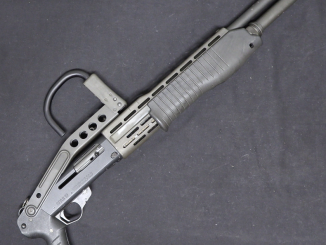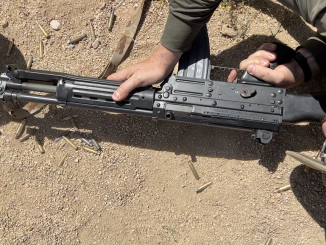I had a different post planned for today, but Michael Heidler sent me some additional photos of the recently-discussed Orita submachine guns that ought to be shared. They are both of the second model, but have slightly different grip safety styles:
[singlepic id=3229 w=320 h=240 float=center]
[nggallery id=183]
Thanks Michael!
Note: If you saw this post earlier and are wondering where the TZ-45 photos went, I apologize. There was a misunderstanding over printing permissions, and we need to take them down at the request of the gun’s owner. Both Leszek and I regret this and apologize, but it is important to respect the wishes of the folks who own these guns.




Remarkeably well thought out guns. While the Italian one logically structured (the aluminum portion is help in lower weight), the Romanian is susprisingly well and robust made. The single position mag design is built truly expertly.
From manufacturing point of view, I’d say that TZ has slight lead. Less manhours = more efficient design.
The strategic bombing campaigns by all sides in World War II targeted steel mills, whose locations were well known and obvious. Aluminum production facilities were rapidly expanded during the war to support aerospace production by all combatants and were much less obvious and hence in better condition afte the war.
The net outcome was a serious shortage of all steel grades across Europe and Asia, but a massive surplus of aluminum as aircraft production collapsed. Most European countries rationed steel into the 1960’s. Britian did not end steel rationing until 1963. All kinds of products which would have been made from steel before the war were made from aluminum after the war because it was available, unlike steel. This is most likely why Eugen Stoner used aluminum in his ArmaLite designs, because the worldwide steel shortages made aluminum a cheaper raw material even in the USA. The 1950s’ aluminum consumer goods have all become much sought after art collectibles.
It is worth noting that this steel shortage was a major driver in the formation of the European Coal and Steel Community which evolved into today’s EU.
I suspect Stoner used aluminum forging because of company’s nature and experience they had in and that was the mentioned airspace (Fairchild Aicraft Co.). In fact, if you look at it (AR15) from certain angle it looks like piece of landing gear.
The perception of the time was to create “light rifle”. The result somehow missed expectation since light bolt goup in combination with DG impingment requires heavy buffer. So, at the end some gain and some miss.
Is it certain that the mag housing is aluminium?
Zinc die castings can look very much like aluminium, it is the weight which is the easy distinguishing feature.
Keith –
Zamak (zinc casting alloy family) turns grey over time, aluminum does not. Most likely aluminum, given the bright white coloration still there after 70 years.
thanks John,
I’ve been giving that some thought over the past few days, helped by the presence of a dis assembled 1950s Myford lathe in the room beside me.
Like the very simillar American Atlas lathes, Myford used lots of zinc die castings and some sand cast aluminium parts to.
The Myford parts are still light in colour.
I don’t know the composition of the alloy used, but I suspect that the greying is dependant upon the ammount of alloying elements present which develop black sulphide tarnish, like copper.
pure zinc sulphide is white, as are zinc oxide and zinc carbonate, which are the likely surface patinas developed on exposure to air and moisture.
I’m rusty on the range of zinc alloys used in die casting, but seem to remember that more recent castings use 99.9% pure zinc – to avoid the problems experienced with some of the older alloys of swelling, cracking and crumbling with age (due to lead contamination).
The die cast parts of US made Atlas lathes have a reputation for crumbling, the British made Myford lathe parts don’t have that reputation, and the apron casting of an ML7 is easily mistaken for an aluminium casting.
Even if it was not used on the Italian TZ45, zinc die casting was used to form the mag housing of the Aussie STEN (Austen) SMG.